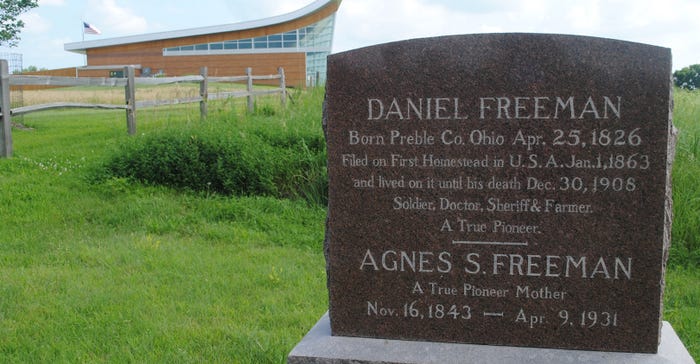
Nebraska is a diverse agricultural state, with a broad and interesting farming and ranching history. Some of the state’s finest ag history museums and educational sites help to tell the story of Nebraska agriculture through time.
In our new series of Nebraska Farmer virtual tours, we encourage teachers, ag students, 4-H and FFA members, farmers and ranchers, and ag history enthusiasts to enjoy some of the state’s unique ag history sites through the camera lens of Nebraska Farmer editors.
Homestead National Monument
“Free land” was an attractive slogan to would-be settlers in the mid-1860s. Daniel Freeman was most likely the nation’s first homesteader to make a land claim under the Homestead Act of 1862. The story goes that the Ohio native filed his claim to land near what is now Beatrice, Neb., at the land office in Brownville, Neb., at 10 minutes after midnight on Jan. 1, 1863 — the date the legislation went into effect.
Related: Finding records of the old homestead
Ken Deardorff proved up on the nation’s last claim on 80 acres on the Stony River in southwestern Alaska in 1979. The Homestead National Monument, located 4 miles west of Beatrice on Freeman’s original land claim, honors all homesteaders — from the first to the last — offering exhibits not only on the Freeman family, but also on the challenges and triumphs of the thousands of homesteaders claiming land under the Homestead Act.
Nebraska Farmer Editor Tyler Harris and Field Editor Curt Arens have visited the Homestead National Monument at different times and chronicled the sites and displays of this unique place in print and through the vision of their cameras.
The story of the Freeman family is the story of American homesteaders through the years, including Deardorff, who homesteaded more than a century later. When the Homestead Act was signed into law by President Abraham Lincoln, the Civil War was raging.
Under the act, a homesteader only had to be the head of the household or at least 21 years old to claim 160 acres of land. The act turned over 270 million acres of land, about 10% of the U.S., to private citizens for settlement and improvement.
Homesteaders had to live on the land, build a home, make improvements and farm for five years before they were eligible to “prove up” on the land. The total cost of filing a claim was a fee of $18. Over the course of the history of the act, farmers from the East without land of their own, single women and formerly enslaved people took up claims and proved up on their land.
The Homestead Act was repealed in 1976, with provisions allowing homesteading in Alaska until 1986.
Related: Thousands make pilgrimage to Homestead for total solar eclipse
Over the years, many notable Americans can claim a close identification with the Homestead Act. Inventor and educator George Washington Carver was born into slavery in Missouri, but in adulthood after the Civil War, he homesteaded in Beeler, Kan., before attending Iowa Agricultural College.
Virgil Earp, a U.S. marshal in Tombstone, Ariz., who was known for his role in the shootout at the O.K. Corral, homesteaded in Prescott, Ariz. Other famous Americans, such as Whoopi Goldberg and Lawrence Welk, were among generations born in homesteading families. Notable Nebraskans, such as Willa Cather and Tom Osborne, also had homesteading families in their background.
On March 16, 1936, President Franklin D. Roosevelt signed a law passed by Congress creating a new unit within the National Park Service to honor the legacy of the Homestead Act on the site of Daniel Freeman’s original homestead claim. Nebraska’s esteemed U.S. senator at the time, George Norris of McCook, was instrumental in this legislation coming to fruition.
Today, the plow-shaped multiuse facility known as the Heritage Center, combined with the nearby Palmer-Epard Cabin, tells the story of homesteading through artifacts and exhibits, as well as multimedia programming. The Heritage Center is where researchers can search for homestead records of relatives through their online digitized resources.
The Education Center is located about three-quarters of a mile away, and consists of hands-on educational displays and special programming, as well as access to tallgrass prairie trails and trails through a quiet, restored bur oak woodland. Near the Education Center is the Freeman School, a country schoolhouse attended by the Freeman children, which operated from 1872 until 1967.
Freeman and his wife, Agnes, are buried on an east upland ridge on the grounds, in full view of the Heritage Center. To date, the Homestead National Monument houses archaeological artifacts, historical objects, scientific specimens and archival documents numbering 944,000 items.
Learn more by visiting nps.gov/home or calling 402-223-3514. Learn about notable Americans with homesteading roots at nps.gov/home/learn/historyculture/homesteadinglegacies.
About the Author(s)
You May Also Like






